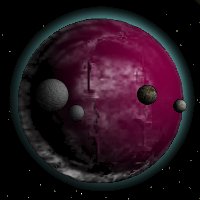
|
| Kaiburr
|
|
Karana System
|
|
1
|
|
4
|
|
598,385,492,374 km (4.0 AU)
|
|
10.4 Standard Hours
|
|
407.1 Standard Days
|
|
Terrestrial
|
|
10,241.8 km at equator
|
|
62% nitrogen, 19% carbon dioxide, 14% oxygen, 5% trace gases
|
|
Cold (Min –80, Mean –34, Max 10˚C)
|
|
Light (0.65 Standard)
|
|
Rough, sparse vegetation, evidence of ancient asteroid impact that wiped out most life
|
|
Galactic Basic
|
|
330
|
|
None
|
|
Necessities
|
|
Lightsaber Crystals
|
|
House Dinaari (Past)
|
History
The early Karanans knew nothing of Kaiburr per se, though their mythos provided that objects more distant from their homeworld were higher in the supernatural order. The gods had to live somewhere. When a small group of Dark Jedi arrived in the system sometime around 3400 BBY they exploited this belief in order to rule the primitives from afar. Their full reasoning may never be known, but it is likely they chose to settle Kaiburr to bask in the dark energies of its ancient cataclysm, for easy access to the local crystal supply, and to extend the range of their sensors out of the system. Their philosophy was apparently similar to the modern Obelisk, though it should be noted that there is no evidence of a connection to the students of Alaiedon.
They built a citadel on their chosen capital planet using slave labour, a position they would leave mysteriously a short time after its completion. The transported Karanans failed to survive this abandonment, their indignation at what they then knew to be false gods still evident in the vandalism done to the ruins. It would take Karanan science nearly a thousand years to discover the planet again.
The Emperor’s Hammer refurbished the ancient mine, recently exhausting the supply of low quality lightsaber crystals there that had once sustained the Dark Jedi of old. Although not as efficient as Adegans and requiring replacement every 1-2 months due to their inherently unstable structure, these crystals are far more efficient than the artificial crystals commonly in use following the Battle of Endor. In addition, their power output and ease of focusing emulate the desirable natural Adegan Crystals.
The planet served as the home of Clan Taldryan’s Obelisk House, Dinaari, which spitefully carted off much of the Hammer’s remaining crystal supply during the Exodus. The planet now lies uninhabited save for a small survey and excavation force.
Satellite Descriptions
Vodahri, the smallest and innermost moon, was also the last to be identified. It was named in honor of the Exalted Unifier, Krazzos Vodahr, in the ninth year of his reign. The moon lacks an atmosphere, and is mostly cratered water-ice.
Guurat is another water-ice moon without an atmosphere or resources of note. It was named after Guurat Numare, Sahare’s most revered collectivist philosopher.
Abrinooth is the largest moon in the system, the first moon of Kaiburr discovered, and has a dense nitrogen atmosphere. It was named after the leader of the High Gods.
Orn is a rocky moon with a thin carbon dioxide atmosphere and a minor kiirium deposit in its southern hemisphere. It bears the name of one of Sahare’s greatest explorers, the first to circumnavigate Sahare.